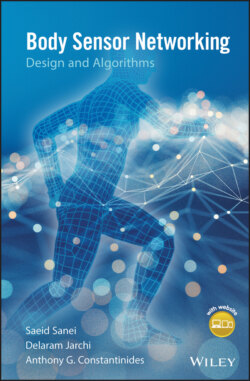Читать книгу Body Sensor Networking, Design and Algorithms - Saeid Sanei - Страница 39
3.5 Conclusions
ОглавлениеSensor technology devices have become more miniaturised, wearable, user-friendly, cost effective, less intrusive, and inclusive, and are often accessible to outpatients and individuals. Human vital signs as well as abnormalities can be captured invasively or noninvasively (and in some cases nonintrusively) by various sensor modalities, some packed together in one package. The new wireless technology in parallel with the advances in high-speed computing systems provides more accurate and accessible health-monitoring systems. Physical, physiological, biological, and other sensor types are fast developing and allow full body screening in all times. Emerging sensor technologies provide constant feedback to individuals and create a safer and healthier world.
Table 3.1 Biosensors, their principle, applications, and bibliography.
| No. | Type | Principle | Applications | Bibliography |
| 1. | Glucose oxidase electrode-based biosensor | Electrochemistry using glucose oxidation | Analysis of glucose in biological sample | Clark and Lyons [45] |
| 2. | HbA1c biosensor | Electrochemistry using ferroceneboronic acid | Robust analytical method for measuring glycated haemoglobin | Wang et al. [52] |
| 3. | Uric acid biosensor | Electrochemistry | For detection of clinical abnormalities or diseases | Erden and Kilic [53] and Kim et al. [54] |
| 4. | Acetylcholinesterase inhibition-based biosensors | Electrochemistry | Understanding pesticidal impact | Pundir and Chauhan [55] |
| 5. | Piezoelectric biosensors | Electrochemistry | Detecting organophosphate and carbamate | Marrazza [56] |
| 6. | Microfabricated biosensor | Optical/visual biosensor using cytochrome P450 enzyme | For drug development | Schneider and Clark [57] |
| 7. | Hydrogel (polyacrylamide)-based biosensor | Optical/visual biosensor | Biomolecular immobilisation | Khimji et al. [58] |
| 8. | Silicon biosensor | Optical/visual/fluorescence | Bioimaging, biosensing, and cancer therapy | Peng et al. [59] and Shen et al. [60] |
| 9. | Quartz crystal biosensor | Electromagnetic | For developing ultrahigh-sensitive detection of proteins in liquids | Ogi [61] |
| 10. | Nanomaterials-based biosensors | Electrochemical or optical/visual/fluorescence | For multifaceted applications including biomedicine, e.g. diagnostic tools | Li et al. [62], Kwon and Bard [63], Zhou et al. [64], Guo [65], Hutter and Maysinger [66], Ko et al. [67], Senveli and Tigli [68], Valentini et al. [69], Lamprecht et al. [70], and Sang et al. [71] |
| 11. | Genetically encoded or fluorescence-tagged biosensor | Fluorescence | For understanding biological process including various molecular systems inside the cell | Randriamampita and Lellouch [72], Oldach and Zhang [73], Kunzelmann et al. [74], and Wang et al. [75] |
| 12. | Microbial fuel-cell-based biosensors | Optical | To monitor biochemical oxygen demand and toxicity in the environment and heavy metal and pesticidal toxicity | Gutierrez et al. [76] and Sun et al. [77] |
Table 3.2 Use of biosensors in disease diagnosis.
| No. | Biosensor(s) | Disease diagnosis or medical applications |
| 1. | Glucose oxidase electrode-based biosensor and HbA1c biosensor | Diabetes |
| 2. | Uric acid biosensor | Cardiovascular and general disease diagnosis |
| 3. | Microfabricated biosensor | Optical corrections |
| 4. | Hydrogel (polyacrylamide)-based biosensor | Regenerative medicine |
| 5. | Silicon biosensor | Cancer biomarker development and applications |
| 6. | Nanomaterials-based biosensors | For therapeutic applications |
